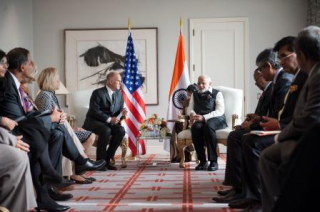


SAN JOSE – Governor Edmund G. Brown Jr. met with Prime Minister of India Narendra Modi today in San Jose to discuss the global fight against climate change. During the meeting, the Governor and Prime Minister agreed to a partnership between California and Indian states, in which California would provide expertise to help India reduce air pollution and combat climate change. The Prime Minister’s visit is the first trip by an Indian head of state to California in more than three decades.
“California and India have a very close and very dynamic relationship,” said Governor Brown. “California has pioneered cleaning up the air and cleaning up the environment over many years. Collaboration on a regulatory and technical level could be helpful. There’s a lot to do.”
The meeting with Prime Minister Modi is the latest in a series between Governor Brown and world leaders. In Seattle on Tuesday, Governor Brown met with President Xi Jinping of the People’s Republic of China after co-chairing the Third U.S.-China Governors Forum and on Friday, Governor Brown continued discussions on climate change in New York City with heads of state from South America and Europe, including Chile’s President Michelle Bachelet, Norway’s Prime Minister Erna Solberg and Hungary’s President János Áder.
These meetings followed a ceremony hosted by Governor Brown in New York City on Thursday to welcome 14 new signatories, including New York City and Italy, to the Under 2 MOU climate agreement.
Additionally, today three European nations – the Netherlands, Luxembourg and the United Kingdom – endorsed the Under 2 MOU at a ceremony with California Secretary for Environmental Protection Matthew Rodriquez at the Netherlands’ Permanent Mission to the United Nations.
With the addition of the 17 new signatories over the past few days, a total of 41 jurisdictions representing 19 countries and five continents have signed or endorsed the Under 2 MOU, collectively representing more than $12.3 trillion in GDP and 387 million people. If the signatories represented a single country, it would be the second largest economy in the world behind only the United States.
The Under 2 MOU is an agreement among cities, states and countries around the world to limit the increase in global average temperature to below 2 degrees Celsius – the warming threshold at which scientists say there will likely be catastrophic climate disruptions.
Governor Brown also gave keynote remarks at an event hosted by the United Nations Environment Programme and the Climate and Clean Air Coalition on short-lived climate pollutants on Thursday. Short-lived climate pollutants include methane, black carbon and hydrofluorocarbons (HFCs) – compounds that have a more potent heat-trapping effect but remain in the atmosphere for a much shorter period of time than carbon dioxide. Reducing these pollutants can have a more immediate beneficial impact on climate change.
In his remarks, Governor Brown outlined goals for cutting methane and HFC emissions in California by 40 percent below current levels by 2030 and black carbon by 50 percent below current levels by 2030.
These goals align with scientific assessments of what is needed globally to limit warming below 2 degrees Celsius. The California Air Resources Board will release a draft strategy next week and host a workshop in October to gather public input. A final proposed strategy will be presented to the board later this year.
In addition to action on the Under 2 MOU, the Governor traveled to the Vatican in Italy and the Climate Summit of the Americas in Toronto, Canada in July to call on the world’s cities, states and provinces to join California in the fight against climate change. These efforts build on other international climate change pacts with leaders from Mexico, China, North America, Japan, Israel and Peru.Governor Brown also helped convene hundreds of world-renowned researchers and scientists to issue a groundbreaking call to action – called the consensus statement – which translates key scientific climate findings from disparate fields into one unified document.
Earlier this year, Governor Brown issued an executive order to reduce greenhouse gas emissions in California 40 percent below 1990 levels by 2030 – the most ambitious target in North America and consistent with California’s existing commitment to reduce emissions 80 percent under 1990 levels by 2050.
In his inaugural address this year, Governor Brown announced that within the next 15 years, California will increase from one-third to 50 percent the electricity derived from renewable sources; reduce today’s petroleum use in cars and trucks by up to 50 percent; double the efficiency savings from existing buildings and make heating fuels cleaner; reduce the release of methane, black carbon and other potent pollutants across industries; and manage farm and rangelands, forests and wetlands so they can store carbon. The impacts of climate change are already being felt in California and will disproportionately impact the state’s most vulnerable populations.
Photo captions can be found below:
1.)Governor Brown and Prime Minister Modi discuss climate change
2.)Governor Brown and Prime Minister Modi
Photo Credit: Joe McHugh, California Highway Patrol. For high resolution copies of these photos, please contact Danella Debel, Office of the Governor at Danella.Debel@gov.ca.gov.

